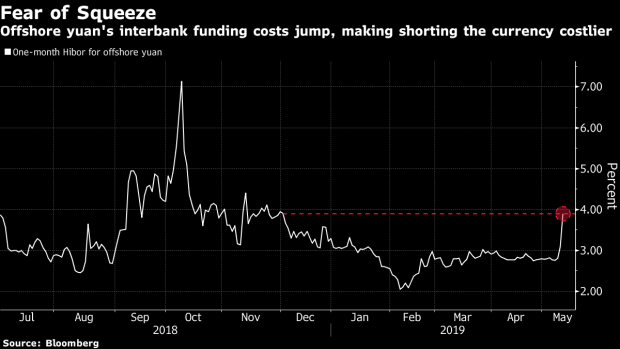May 14, 2019
PBOC's Presence Seen to Prevent Yuan From Deeper Plunge
, Bloomberg News

(Bloomberg) -- The possibility of intervention by the Chinese central bank is preventing a deeper plunge in the yuan.
The People’s Bank of China will want to keep the currency stronger than 7 per dollar -- a level unseen since the financial crisis -- as a break may lead to a "vicious cycle" of capital outflows and sharper depreciation, according to Macquarie Securities Ltd.
Traders are apparently reluctant to short the yuan aggressively, with an indicator of bearish bets in the options market at one-third of a peak seen in 2015. The PBOC’s move to choke bears in 2017 may also be fresh in the memory.
When the yuan edged closer to 7 last year, the PBOC signaled tougher control of its currency in its monetary report and sold bills in Hong Kong -- a move that could tighten liquidity and buoy the exchange rate.
"The market isn’t panicking, as most people think the PBOC will be able to defend the yuan at 7 and the trade talks didn’t collapse," said Larry Hu, head of Chinese economics at Macquarie. The central bank can stabilize the exchange rate by setting strong fixings and selling the dollar directly in the spot market, he added. "Also, China doesn’t want the currency to be too weak as that will make negotiations with the U.S. tougher."
The offshore currency pared some of its earlier losses Tuesday, after slumping for six sessions to as weak as 6.9185 per dollar on Monday, a level unseen since December. China-U.S. trade tensions were eased as President Donald Trump said talks are “going to be very successful" and the yuan’s interbank borrowing costs spiked in Hong Kong. The PBOC plans to sell 20 billion yuan ($2.9 billion) of bills in the city on Wednesday, further draining cash in the market.
Here are three charts showing why recent declines failed to trigger panic in the market:
The PBOC has set its daily reference rate for the yuan at levels that are stronger than the average forecasts traders and analysts offered to Bloomberg for five sessions in a row, the longest run this year. The rate, which is also known as the fixing, restricts the onshore yuan’s moves by 2% on either side.
The offshore yuan’s one-month interbank borrowing costs, known as Hibor, jumped to the highest level since December, following a surge in the currency’s forward points in the foreign-exchange market. That means supply of the yuan is tightening in Hong Kong, so short selling the currency is more expensive.
The move reminds investors of PBOC intervention in early 2017, when the central bank burned bears by mopping up liquidity in Hong Kong -- a move that sent the overnight deposit rate in the city to as high as a record 100%.
The yuan’s three-month risk reversal, an indicator of traders’ bearishness in the the market, remains low compared with levels seen in the aftermath of China’s currency devaluation in 2015. That’s the case even though the gauge has jumped more than one percentage point in May.
--With assistance from Ran Li.
To contact the reporter on this story: Tian Chen in Hong Kong at tchen259@bloomberg.net
To contact the editors responsible for this story: Sofia Horta e Costa at shortaecosta@bloomberg.net, David Watkins, Philip Glamann
©2019 Bloomberg L.P.